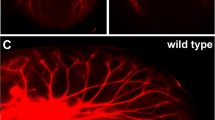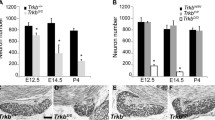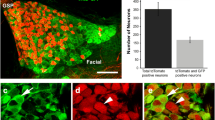Abstract
Taste buds and the peripheral nerves innervating them are two important components of the peripheral gustatory system. They require appropriate connections for the taste system to function. Neurotrophic factors play crucial roles in the innervation of peripheral sensory organs and tissues. Both brain-derived neurotrophic factor (BDNF) null-mutated and neurotrophin-4 (NT-4) null-mutated mice exhibit peripheral gustatory deficits. BDNF and NT-4 bind to a common high affinity tyrosine kinase receptor, TrkB (NTRK-2), and a common p75 neurotrophin receptor (NGFR). We are currently using a transgenic mouse model to study peripheral taste system development and innervation in the absence of both TrkB ligands. We show that taste cell progenitors express taste cell markers during early stages of taste bud development in both BDNF−/−xNT-4−/− and wild-type mice. At early embryonic stages, taste bud progenitors express Troma-1, Shh, and Sox2 in all mice. At later stages, lack of innervation becomes a prominent feature in BDNF−/−xNT-4−/− mice leading to a decreasing number of fungiform papillae and morphologically degenerating taste cells. A total loss of vallate taste cells also occurs in postnatal transgenic mice. Our data indicate an initial independence but a later permissive and essential role for innervation in taste bud development and maintenance.




Similar content being viewed by others
References
Agerman K, Hjerling-Leffler J, Blanchard MP, Scarfone E, Canlon B, Nosrat C, Ernfors P (2003) BDNF gene replacement reveals multiple mechanisms for establishing neurotrophin specificity during sensory nervous system development. Development 130:1479–1491
Barlow LA, Northcutt RG (1995) Embryonic origin of amphibian taste buds. Dev Biol 169:273–285
Barlow LA, Northcutt RG (1998) The role of innervation in the development of taste buds: insights from studies of amphibian embryos. Ann N Y Acad Sci 855:58–69
Cho TT, Farbman AL (1999) Neurotrophin receptors in the geniculate ganglion. Brain Res Mol Brin Res 68:1–13
Conover JC, Erickson JT, Katz DM, Bianchi LM, Poueymirou WT, McClain J, Pan L, Helgren M, Ip NY, Boland P, Friedman B, Wiegand S, Vejsada R, Kato AC, DeChiara TM, Yancopoulos GD (1995) Neuronal deficits, not involving motor neurons, in mice lacking BDNF and/or NT4. Nature 375:235–238
Ernfors P, Merlio J, Persson H (1992) Cells expressing mRNA for neurotrophins and their receptors during embryonic rat development. Eur J Neurosci 4:1140–1158
Ernfors P, Lee KF, Jaenisch R (1994) Mice lacking brain-derived neurotrophic factor develop with sensory deficits. Nature 368:147–150
Ernfors P, Kucera J, Lee KF, Loring J, Jaenisch R (1995) Studies on the physiological role of brain-derived neurotrophic factor and neurotrophin-3 in knockout mice. Int J Dev Biol 39:799–807
Farinas I, Yoshida CK, Backus C, Reichardt LF (1996) Lack of neurotrophin-3 results in death of spinal sensory neurons and premature differentiation of their precursors. Neuron 17:1065–1078
Fritzsch B, Sarai PA, Barbacid M, Silossantiago I (1997) Mice with a targeted disruption of the neurotrophin receptor trkB lose their gustatory ganglion cells early but do develop taste buds. Int J Dev Neurosci 15:563–576
Guagliardo NA, Hill DL (2007) Fungiform taste bud degeneration in C57BL/6J mice following chorda-lingual nerve transection. J Comp Neurol 504:206–216
Harada H, Kettunen P, Jung HS, Mustonen T, Wang YA, Thesleff I (1999) Localization of putative stem cells in dental epithelium and their association with Notch and FGF signaling. J Cell Biol 147:105–120
Hosley MA, Hughes SE, Oakley B (1987) Neural induction of taste buds. J Comp Neurol 260:224–232
Jitpukdeebodintra S, Chai Y, Snead ML (2002) Developmental patterning of the circumvallate papilla. Int J Dev Biol 46:755–763
Kemler R, Brulet P, Schnebelen MT, Gaillard J, Jacob F (1981) Reactivity of monoclonal antibodies against intermediate filament proteins during embryonic development. J Embryol Exp Morphol 64:45–60
Knapp L, Lawton A, Oakley B, Wong L, Zhang C (1995) Keratins as markers of differentiated taste cells of the rat. Differentiation 58:341–349
Krimm RF, Miller KK, Kitzman PH, Davis BM, Albers KM (2001) Epithelial overexpression of BDNF or NT4 disrupts targeting of taste neurons that innervate the anterior tongue. Dev Biol 232:508–521
Liebl DJ, Mbiene JP, Parada LF (1999) NT4/5 mutant mice have deficiency in gustatory papillae and taste bud formation. Dev Biol 213:378–389
Liebl DJ, Klesse LJ, Tessarollo L, Wohlman T, Parada LF (2000) Loss of brain-derived neurotrophic factor-dependent neural crest-derived sensory neurons in neurotrophin-4 mutant mice. Proc Natl Acad Sci USA 97:2297–2302
Liu X, Ernfors P, Wu H, Jaenisch R (1995) Sensory but not motor neuron deficits in mice lacking NT4 and BDNF. Nature 375:238–241
Luukko K, Arumäe U, Karavanov A, Moshnyakov M, Sainio K, Sariola H, Saarma M, Thesleff I (1997) Neurotrophin mRNA expression in the developing tooth suggests multiple roles in innervation and organogenesis. Dev Dyn 210:117–129
Mbiene JP, MacCallum DK, Mistretta CM (1997) Organ cultures of embryonic rat tongue support tongue and gustatory papilla morphogenesis in vitro without intact sensory ganglia. J Comp Neurol 377:324–340
Mistretta CM, Haus LF (1996) Temporal and spatial patterns of tenascin and laminin immunoreactivity suggest roles for extracellular matrix in development of gustatory papillae and taste buds. J Comp Neurol 364:535–555
Mistretta CM, Goosens KA, Farinas I, Reichardt LF (1999) Alterations in size, number, and morphology of gustatory papillae and taste buds in BDNF null mutant mice demonstrate neural dependence of developing taste organs. J Comp Neurol 409:13–24
Mistretta CM, Liu HX, Gaffield W, MacCallum DK (2003) Cyclopamine and jervine in embryonic rat tongue cultures demonstrate a role for Shh signaling in taste papilla development and patterning: fungiform papillae double in number and form in novel locations in dorsal lingual epithelium. Dev Biol 254:1–18
Nakayama A, Miura H, Shindo Y, Kusakabe Y, Tomonari H, Harada S (2008) Expression of the basal cell markers of taste buds in the anterior tongue and soft palate of the mouse embryo. J Comp Neurol 509:211–224
Northcutt RG, Barlow LA (1998) Amphibians provide new insights into taste-bud development. Trends Neurosci 21:38–43
Nosrat CA (1998) Neurotrophic factors in the tongue; expression patterns, biological activity, relation to innervation and studies of neurotrophin knockout mice. Annals N Y Acad Sci 855:28–50
Nosrat CA, Olson L (1995) Brain-derived neurotrophic factor mRNA is expressed in the developing taste bud-bearing tongue papillae of rat. J Comp Neurol 360:698–704
Nosrat CA, Ebendal T, Olson L (1996) Differential expression of brain-derived neurotrophic factor and neurotrophin 3 mRNA in lingual papillae and taste buds indicates roles in gustatory and somatosensory innervation. J Comp Neurol 376:587–602
Nosrat CA, Blomlof J, ElShamy WM, Ernfors P, Olson L (1997) Lingual deficits in BDNF and NT3 mutant mice leading to gustatory and somatosensory disturbances, respectively. Development 124:1333–1342
Nosrat IV, Lindskog S, Seiger Å, Nosrat CA (2000) Lingual BDNF and NT-3 mRNA expression patterns and their relation to innervation in the human tongue: similarities and differences compared with rodents. J Comp Neurol 417:133–152
Nosrat I, Seiger A, Olson L, Nosrat CA (2002) Expression patterns of neurotrophic factor mRNAs in developing human teeth. Cell Tissue Res 310:177–187
Nosrat IV, Agerman K, Marinescu A, Ernfors P, Nosrat CA (2004) Lingual deficits in neurotrophin double knockout mice. J Neurocytol 33:607–615
Oakley B, Witt M (2004) Building sensory receptors on the tongue. J Neurocytol 33:631–646
Okubo T, Pevny LH, Hogan BL (2006) Sox2 is required for development of taste bud sensory cells. Genes Dev 20:2654–2659
Pispa J, Thesleff I (2003) Mechanisms of ectodermal organogenesis. Dev Biol 262:195–205
Ringstedt T, Ibáñez CF, Nosrat CA (1999) Role of BDNF in target invasion in the gustatory system. J Neurosci 19:3507–3518
Rochlin MW, O’Connor R, Giger RJ, Verhaagen J, Farbman AI (2000) Comparison of neurotrophin and repellent sensitivities of early embryonic geniculate and trigeminal axons. J Comp Neurol 422:579–593
Sauka-Spengler T, Bronner-Fraser M (2008) A gene regulatory network orchestrates neural crest formation. Nat Rev Mol Cell Biol 9:557–568
Segal RA (2003) Selectivity in neurotrophin signaling: theme and variations. Annu Rev Neurosci 26:299–330
Sollars SI, Bernstein IL (2000) Neonatal chorda tympani transection permanently disrupts fungiform taste bud and papilla structure in the rat. Physiol Behav 69:439–444
Sollars SI, Smith PC, Hill DL (2002) Time course of morphological alterations of fungiform papillae and taste buds following chorda tympani transection in neonatal rats. J Neurobiol 51:223–236
Suzuki Y (2008) Expression of Sox2 in mouse taste buds and its relation to innervation. Cell Tissue Res 332:393–401
Takeda M, Suzuki Y, Obara N, Uchida N, Kawakoshi K (2004) Expression of GDNF and GFR alpha 1 in mouse taste bud cells. J Comp Neurol 479:94–102
Takeda M, Suzuki Y, Obara N, Tsunekawa H (2005) Immunohistochemical detection of neurotrophin-3 and -4, and their receptors in mouse taste bud cells. Arch Histol Cytol 68:393–403
Thesleff I, Sharpe P (1997) Signalling networks regulating dental development. Mech Dev 67:111–123
Thirumangalathu S, Harlow DE, Driskell AL, Krimm RF, Barlow LA (2009) Fate mapping of mammalian embryonic taste bud progenitors. Development 136:1519–1528
Vintschgau MV, Hönigschmied J (1877) Nervus glossopharyngeus und Schmeckbecher. Arch Ges Physiol 14:443–448
Wakisaka S, Daikoku H, Miyawaki Y, Youn SH, Maeda T, Kurisu K (1998) Immunohistochemical observation of growth-associated protein 43 (Gap-43) in the developing circumvallate papilla of the rat. Cell Tissue Res 293:499–507
Wilkinson GA, Farinas I, Backus C, Yoshida CK, Reichardt LF (1996) Neurotrophin-3 is a survival factor in vivo for early mouse trigeminal neurons. J Neurosci 16:7661–7669
Yee CL, Jones KR, Finger TE (2003) Brain-derived neurotrophic factor is present in adult mouse taste cells with synapses. J Comp Neurol 459:15–24
Zhang C, Cotter M, Lawton A, Oakley B, Wong L, Zeng Q (1995) Keratin 18 is associated with a subset of older taste cells in the rat. Differentiation 59:155–162
Zhang CX, Brandemihl A, Lau D, Lawton A, Oakley B (1997) BDNF is required for the normal development of taste neurons in vivo. Neuroreport 8:1013–1017
Acknowledgments
We thank Waldemar De Reijk and Nancy Pecora for SEM, Michael Whitt for use of confocal microscope, Hirohito Miura for technical advice, Satoshi Wakisaka for helpful discussions, and Michelle Sims for technical assistance.
Author information
Authors and Affiliations
Corresponding author
Additional information
This work was supported by NIH-NIDCD R01-RDC007628.
Rights and permissions
About this article
Cite this article
Ito, A., Nosrat, C.A. Gustatory papillae and taste bud development and maintenance in the absence of TrkB ligands BDNF and NT-4. Cell Tissue Res 337, 349–359 (2009). https://doi.org/10.1007/s00441-009-0833-7
Received:
Accepted:
Published:
Issue Date:
DOI: https://doi.org/10.1007/s00441-009-0833-7




